Hello everybody! I know some of you have been waiting for my doenjang and ganjang recipes for a long time! Today I feel a real sense of achievement to release this recipe here. It’s one of the recipes in my cookbook, and whether you have my book or not, this video and recipe should still be useful to you.
Korean fermented soybean paste, called doenjang (된장), is more than just a seasoning or an essential ingredient in many iconic Korean dishes. It’s part of who we are as Koreans and how we see ourselves. A meal of rice, kimchi, doenjang-soup (or doenjang-stew), and a few side dishes is for many Koreans, the definition of a meal: breakfast, lunch, or dinner. It’s impossible for us to imagine life without doenjang.
Salty, earthy, hearty, incredibly savory and delicious, it adds flavor to many dishes and makes them distinctively Korean. Making doenjang at home takes a long time, you have to be ready to commit to it for one year! It’s not hard to make, but takes patience and some hard work, and some special equipment. But as a bonus, Korean soup soy sauce (guk-ganjang:국간장) is a byproduct of making doenjang, so you get that delicious soy sauce for free!
Of course, you can always buy doenjang and guk-ganjang in a Korean grocery store, which is what most Koreans do. But the taste of store-bought can’t be compared to homemade doenjang and guk-ganjang, you will be knocked out over how delicious they are! And I’ve never found a brand of soup soy sauce in the store that satisfied me, which is why I always use fish sauce in my recipes as a substitute.
Besides the taste, making your own is fun and satisfying to eat. Over years of making, tasting, and fermenting these iconic Korean sauces, you’ll develop experience and sophistication in fermenting and eventually become a Korean food expert.
This video was a lot of fun to make. The recipe took me 2 years to develop, and the video took another year to film. It’s finally finished and I couldn’t be happier to share my recipe with you! Koreans traditionally start the process in the winter because the weather is good for drying soybean blocks. But I discovered that indoors, in my apartment in New York, any time is a good time to start making doenjang.
I hope you try it! Enjoy the recipe!
Special equipment
- An electric mat or blanket, or ondol-style heating in your house
- Cotton flour sacking or cheesecloth
- Cotton butcher’s twine
- A large shallow bamboo basket about 17 inches in diameter, or a large baking pan lined with waxed paper
- Dried rice straw or hay that’s been well washed and dried (optional)
- A cardboard box (an 18-x-10-x-7-inch box will hold 3 bean blocks)
- A 4- to 5-gallon Korean earthenware crock (hangari) with a lid
- A 5-quart Korean earthenware crock (hangari) with a lid
- 3-5 dried jujubes (daechu)
- 3-5 large dried hot chili red peppers (any variety; about 4 inches long)
- 3 (4-x-1½-x-1-inch) pieces hardwood charcoal
Ingredients
Makes 10 pounds of doenjang
- 5 pounds dried yellow soybeans (meju-kong), picked over, rinsed, and soaked in cold water for 24 hours
- 3½ gallons water
- 5 quarts plus ½ cup kosher salt (2 three-pound boxes of Diamond Crystal brand Kosher salt)
- 2 tablespoons honey
How to make doenjang
Make meju blocks from soybeans
Blocks of crushed soybeans are called meju (메주) in Korean, and they’re the foundation of doenjang-making.
- Drain the beans and put them in a large heavy pot. Add water that is three times as deep as the beans, cover, and cook over medium-high heat for 1 hour.
- Turn the heat down to medium and continue cooking until the beans are soft enough mash easily, 4½ to 5 hours, checking to make sure the beans remain covered with water, and replenishing as necessary. Drain the beans in a colander.
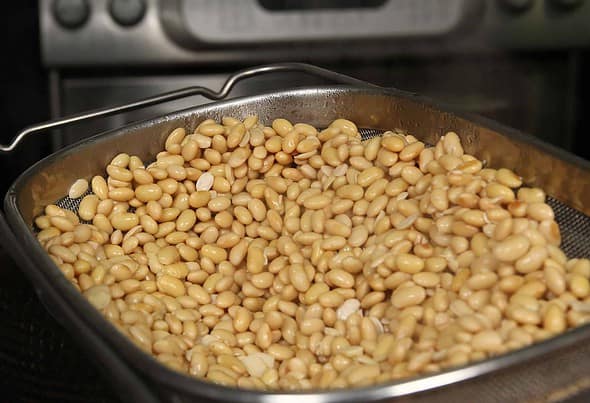
- Mash the drained beans to a paste in batches with a large mortar and pestle or in a food processor. Don’t finely grind them, leave some beans half-crushed.

- Divide the mashed beans into 3 portions. Knead each portion with both hands and shape into a firm rectangular block measuring 6 x 3 x 4 inches.


Ferment the meju
- Traditionally Koreans dry meju on the heated ondol floors of their homes, and if you live in Korea or have that kind of heating in your house, you can do that too. But in my NYC apartment I simulate ondol by putting an electric blanket on the floor. Line the blanket with a clean cotton cloth or waxed paper and set the blocks on top, or put them in an open basket. Set the heat to low. Dry the blocks, rotating them occasionally, until they are solid enough to hang, 3 to 4 days.

- Tie each block up in cotton twine and hang them. You can hang them outside but be sure to keep them covered and out of the rain, and if it’s too hot out they may rot. Inside, you can hang them from the ceiling with hooks. Wherever they hang, the spot should be cool and well-ventilated and all sides of the blocks should be exposed to air and not touching each other. Let the blocks hang for 6 weeks, until they are well dried out and smell a little pungent when you get your nose close to them.

- Now it’s time to ferment the bean blocks. Place a layer of dried rice straw or hay in the bottom of a cardboard box that’s just big enough to hold the blocks with a little space between them; the straw will insulate the blocks and attract good bacteria like Bacillus subtilis in the air. (Don’t worry if you can’t find straw or hay; the blocks will still attract good bacteria.)

- Cover the box and put it on the electric blanket. Set the heat to low and let the bean blocks ferment for 2 weeks. At this point, the well-fermented bean blocks will smell a little earthy and pungent and will be covered with white, brownish-yellow, or sometimes greenish fungi. (These fungi change the bean proteins to peptides and amino acids, which will give the bean paste its delicious nutty flavor.)
- Tie the fermented bean blocks up in cotton twine and hang from the ceiling, as before, for 1 month.


Soak the meju in brine
- Wash the blocks in cold water and to remove the fungi. Place the blocks in a shallow basket or on a baking sheet lined with waxed paper and let them dry in the sunlight for 1 day, turning them until every side of each block is dried.

- Combine the 3½ gallons water (56 cups) and 5 quarts of the kosher salt (20 cups) in a large bowl. Stir with a wooden spoon until the salt is thoroughly dissolved.
- Set out a 4- to 5-gallon earthenware crock. Put 2 pieces of the charcoal on a gas burner; turn on the flame, and heat until they are glowing red. (If you don’t have a gas burner, use the broiler: Put the charcoal pieces under the broiler and turn it on; remove the charcoal when it is red.) Use tongs to transfer the charcoal to the earthenware crock. Drizzle the honey over the burning charcoal. Cover the crock and wait for 5 minutes.

- Remove the lid. You will see lots of smoke and smell a good caramel aroma. This process sterilizes the inside of the crock and will give the sauce good flavor.
- Remove the charcoal and wipe the inside of the crock with paper towels. Add the bean blocks and salted water to the crock. Add the remaining piece of charcoal, the jujubes, and dried hot peppers; they will float on the surface of the water. (The charcoal will attract and absorb any dust. The jujubes add sweetness and the dried red peppers help prevent the blocks from going bad.) Evenly sprinkle ¼ cup salt over the tops of the meju blocks exposed to the air.

- Cover the crock with flour sacking or cheesecloth and put on the lid. Let the blocks soak in the salty water until well fermented, 2 to 3 months. On clear days remove the lid and let the crock sit in the sunlight. Close it at night and be sure to keep the crock covered with the cloth so bugs and dust can’t get in. As time passes, the salty water will turn brown and smell like deeply fermented soy sauce.

Separate the doenjang from the soy sauce
- Discard the charcoal, jujubes, and peppers. Transfer the soaked bean blocks to a large bowl. The blocks may have broken up during the soak, so use a bowl to scoop the soy sauce out of the crock and into a strainer set over another large bowl. Add any pieces of bean block to the bean block bowl. Save the soy sauce for making Korean soup soy sauce (gukganjang) later.
- Mix the doenjang with both hands, breaking it up into a paste, and transfer it to a 5-quart earthenware crock. Pack it down and sprinkle with the remaining ¼ cup kosher salt. Cover with the cotton cloth, secure it with a rubber band, and put on the lid.
- Put the doenjang crock in a sunny spot for its final fermentation. About twice a week on sunny days, remove the lid and let the sunlight shine into the crock through the cotton cloth. When it’s well fermented, the doenjang will smell sweet and taste salty and earthy, with a deep flavor. This will take 5 to 6 months. If it ever looks a little too dry on top, pour some of the separated soy sauce on top to make it moist again. You don’t need to stir it in.

Serving and storage
- Store the doenjang in the crock outside the house or at room temperature. Whenever you take some out, press the rest down with a spoon to keep out the air. Once in a while, take the lid off, cover with a cotton cloth, and let the sun hit it again.
Doenjang-making diary
Here’s a schedule of dates from a year of my doenjang-making. You might need to deviate from this timeline depending on how your project is going, but you get the idea of how long it takes and where you should be every month.
January 4 — Soaked the beans.
January 5 — Made the meju.
January 9 — Hung the meju up.
February 24 — Put the meju in a box with hay.
March 10 — Took the meju out of the box and hung them up.
April 10 — Washed the meju and let them dry in the sunlight.
April 11 — Soaked the meju in salty water.
June 11 — Separated doenjang and guk-ganjang.
June 22 — Made guk-ganjang.
December 1st — Doenjang was ready.
Maangchi's Amazon picks for this recipe
It's always best to buy Korean items at your local Korean grocery store, but I know that's not always possible so I chose these products on Amazon that are good quality. See more about how these items were chosen.



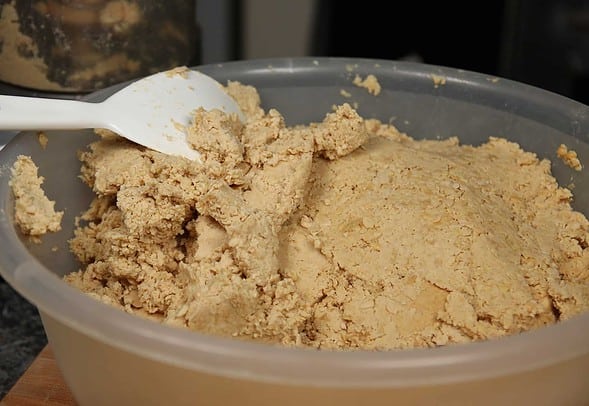
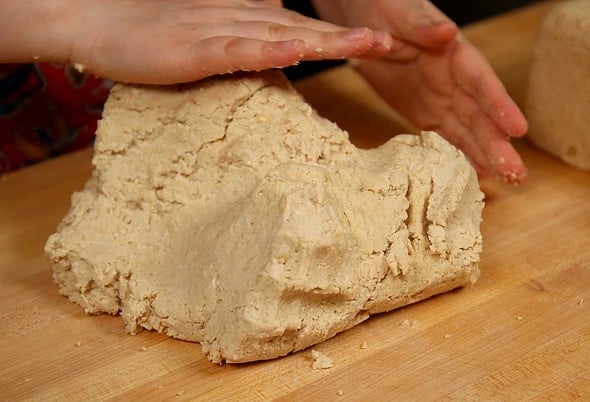
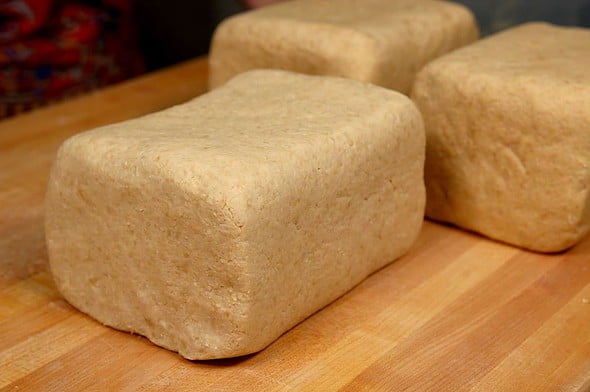
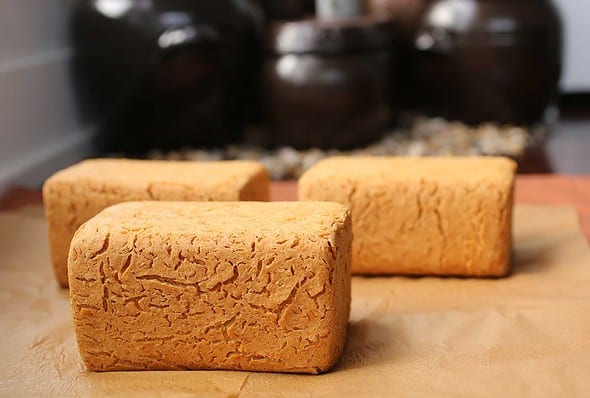
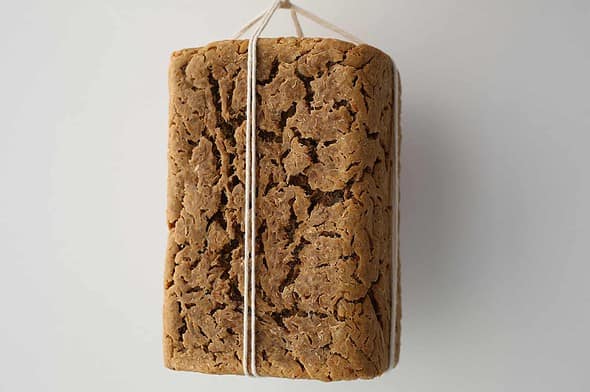
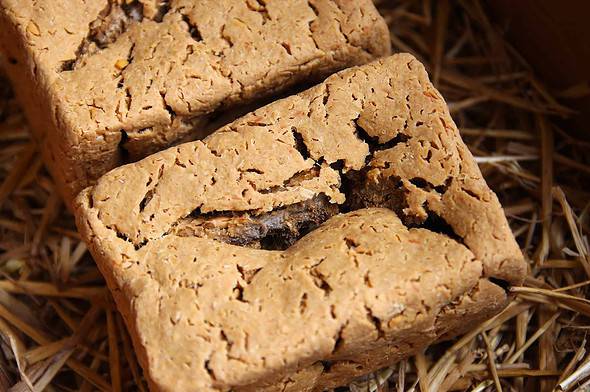
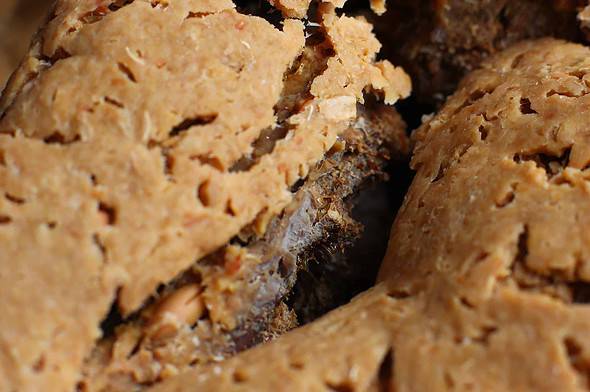
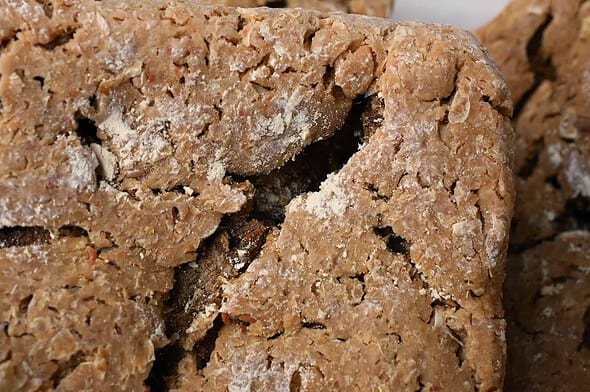
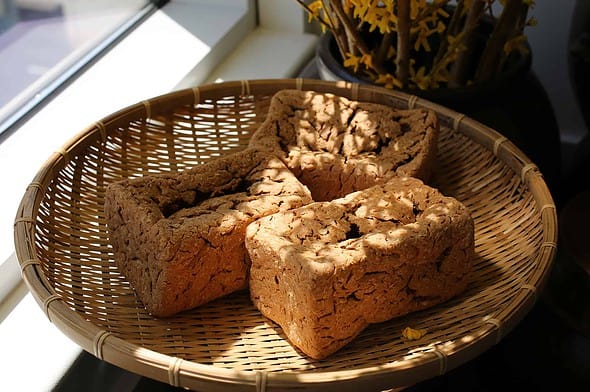
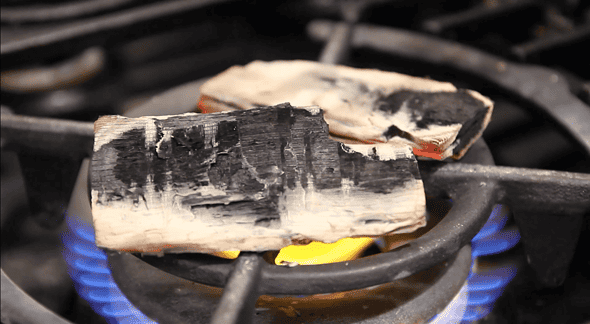
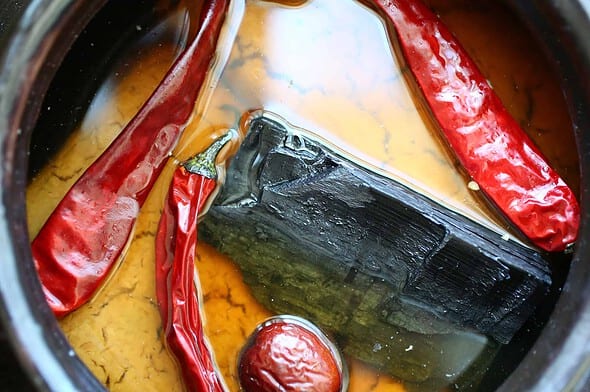
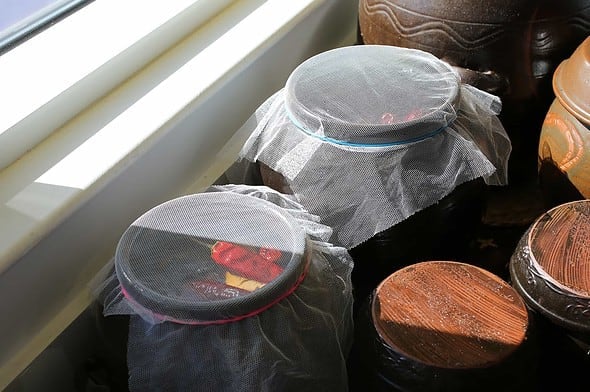
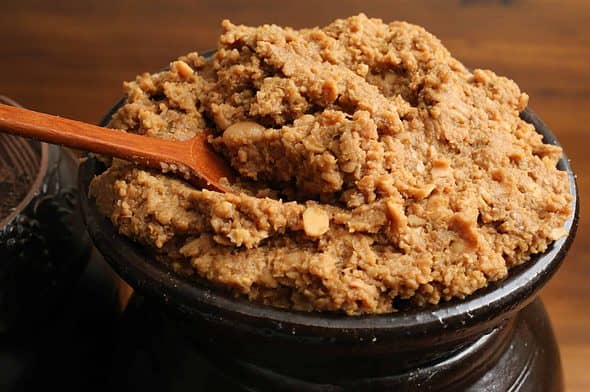























I read everyone comment, most people can get wood charcoal but because i cant find a reliable food grade wood charcoal, i m thinking to replace with activated carbon. Dear Maangchi, is it ok to get clay type ware for fermentation, seller said it was use for wine making, breathable. Thank you
I have four block, after 36 hours, two blocks showed white spot on it and another two not yet
See full size image
Oh no, the third day of fermentation, i observed some black mold on the block, white one more than black one but i am too worried so i cut off the black mold and hope that the white one can outgrow black mold.
The day 3 photo
See full size image
You did a great job cutting off the black mold! Good lucK!
Dear Maangchi, thank you for your encouraging, this project just started three days, i am so worried my baby meju everyday. Still a long way to worry, but i will do ny best
As long as you give them good care like that, I’m sure the meju blocks will turn out good! When I ferment my meju, I’m always excited to see them and even the stinky smell makes me happy. “uh? where is this smell coming from?” Then I realize it’s coming from my meju hung on the wall, then I smile. It’s so fun doing a long time project.
Oh found orange colour mold on block. I removed orange mold. I still pick out black mold Everyday but now the block is getting dry so less black mold spot on block. The soybean block now have ammonia smell and kind of stinky but me and my mom love the smell
See full size image
Thank you so very much for posting this recipe! I can’t wait to try it. I have two questions to start with: do you know if this method has been used with other legumes? and 2) do you have a source for ceramic onggi–or another type of breathable pot? I have tried to find large enough ones online to no avial. Thanks again. Melissa
Hello Maangchi!
I’ve been making doenjang and already soaked my doenjang in brine inside an earthernware pot.
After several days, I found a growing white fungus on top of the brine, I took a picture of it.
Is it okay or should I change the brine?
Usually I put it outside and sunbathe it on sunny days, but I never let water goes inside.
Thank you for your help! I look forward to eat a very delicious earthy doenjang based on your recipe^^
See full size image
I would like to have your thinking about these one, i am not really sure about black/dark blue fungus, my first try.. thanks a loooooot for all your yummy videos! hug from France see youuuu!
See full size image
Maangchi, you are so awesome. I was one of the people begging you to post this, probably 10 years back! I just happened upon it here today. Thank you so much, and thanks also for helping people through the process. Time for me to get on it! I will definitely be buying your book.
So it’s been two months now and I decided to separate my soy sauce and bean paste without looking at the video D: I watched it after separating and I noticed that my soy sauce didn’t really have any fungi in it and it looks rather pale :( The picture I added has dark soy sauce next to it as a colour reference :)
I also found these pink bug-like things in my soy sauce a month ago but wasn’t really concerned since it was just four pieces. I’ve put a picture of what I say just in case but they were really tiny and they were a size of a rice grain. I’m rather confused as to what should I do next so please help D:
See full size image
Oh here’s the bug-like things I found. They weren’t moving when I got them out :/
See full size image
After separating the doenjang from ganjang (salty soy sauce), it should be fermented in an earthenware crock (onggi). Onggi has microscopic holes. These micropores allow some gases to pass in and out, and the porosity of the vessel enables the fermentation process to regulate itself.
If you really like to make Korean doenjang annually, you should try to get an earthenware crock.
However, you used a glass jar. I hope the taste is alright.
“..really tiny and they were a size of a rice grain”. If it happened to me, I would throw it out.
But if you want to save it and eat it, boil the soy sauce for a long time before eating.
Ah so the earthenware is super important then :/ I’ll probably just throw it away then since I can’t really identify those pink things myself.
For the earthenware crock, would any ceramic be fine?
Hello from Syria :-)
My name is Siraj
I’m so intrested in slow food, especially soy products, I tried making Miso many times, but never succeeded cause we need Kuji, that’s why I loved doenjang cause it ferments natuarlly, these in the photo are my meju blocks, two batches, the first (three blocks) is very good, well dried and smell delicious, but the second I threw away cause they rot and a ton of worms came out of it, plus many neighbors ended up in the emergency room hhhhh (kidding)… anyways my question is ; can I use glass jars instead of hangari? We don’t have any in Syria and no high quality pottery in here especially during this massive war….
Thank you, and wish me to still being alive to see my deonjang :-D so please be grateful that you live in (peacful) places :-*
See full size image
I started make this from last week. I hang the blocks yesterday but I already find some black fungi inside one of the blocks. Should I throw this block away? Or it is normal? Thank you!
See full size image
It’s not exactly black fungi. Black means real black. Yours looks dark brown and also white fungi is growing inside and outside the meju. Don’t throw it away. Later when you make doenjang and ganjang, wash it with a kitchen brush to remove any fungi and dry it before soaking it in salty water. Your meju is being well fermented! Congratulations!
I have been soaking my meju in salty water for 2 months now. Soon I have to separate them. I’m very excited to see my project! Now your meju photo is adding to my excitement.
A few of mine are starting to do this as well. This is my second attempt, (my first time I did two batches as well, one survived and is in the salt water now) I had started some about two weeks ago, and they did that as well. I threw them out because I was worried. So Sunday I made a new lot. I’m glad I’m not the only one with these issues.
See full size image
Can’t wait until June!
See full size image
(I mean December, it will be ready in June, oops! ;))
Maangchi can I use something to dry it not the electric mat I don’t wanna use it what should I use ?
You could try to put it in the closet where your boiler is XD It worked pretty well for mine :P
Hello, Maangchi! I have developed a fascination with Korean cuisine and cooking thanks to your videos. I decided to try my hand at doenjang. The saleslady at the Korean store was very excited to hear that I was going to attempt it. Everything with the soaking and cooking of the beans went beautifully. My meju blocks were gorgeous! I set my heating mat up on a low table, placed a cotton towel on top and then my blocks on top of that.
I was so excited to wake up and turn them this morning! Imagine how crushed I was to see that my little dog had pulled the cotton cloth to the edge of the table, and then eaten chunks out of all three meju blocks! It’s a relatively small amount gone, but I do have some concerns around fermenting the blocks with dog germs on them, so I’m going to start another round of beans soaking tomorrow.
I am, however, going to keep the dog-eaten blocks so that I can see how they behave as I go through the process. So, I guess this isn’t so much a question as a cautionary tale to others who might think that their dogs won’t be interested soybean blocks.
Thanks so much for the work that you do! Millions of lives are all the more delicious because of it. I’ll attach a picture of my pre-dog bite meju blocks.
See full size image
Thank you for sharing your cute meju story with us!
Your new 3 meju blocks placed on electric mat nicely right next to window look so beautiful. I can see your good care. You will check out the meju all the time and you will feel excited. I’m sure they will ferment nicely and you will make delicious ganjang and doenjang later.
Yes, don’t throw away the dog-eaten blocks. You still can use them. Before adding them to salty water later, you will wash them and dry again, so you don’t have to worry much.
I didn’t know a dog is interested in eating meju but why not? When the meju is still moist, it could be good snack. : )
cats & dogs
my cat also tasted from the meju blocks but is mostly worried because I use it’s best sunny and warm spot.
See full size image
I received your comment and laughed out loud! Your menu blocks (and your cat) look beautiful! My dog has four different beds spread throughout the house, each one catching the sun at different times of the day. Fortunately, she can’t get onto my sunny menu block table. But she can grab the edges of the towel to move them closer to her mouth. I can’t wait to see how your soybeans turn out!
Thank you for sharing the cute story about your dog! “she can grab the edges of the towel to move them closer to her mouth.” haha, smart!
Those are good looking meju! : )
Hi dear
now past 2month and havent any fungi on top of my 국간장
I should wait until comming fungi on top of my 국간장?? or no now is ready???
thanks my dear
See full size image
Your soy sauce looks dark brown which means it’s well fermented! Congratulations! Well done!
Hi Maangchi, I was glad I found this recipe in your website. At first I was hesitant to try this out since it will take a long time for this recipe but I still gave in (hahaha). A week ago I started making my own meju blocks. I made 2 mini meju blocks about a size of a tofu. Since we don’t have ondol and also don’t have a heating mat I decided to use the oven to dry up my mini blocks. I left the blocks inside my oven a day after I dried them up since I was busy and have forgotten to take them out of the oven. The next day i took them out of the oven and found some white and black fungi on it. So i decided to hang them out and cover it with my cheese cloth to prevent some fruit flies going in my blocks. After 3 days more black and white fungi is building up. Now I feel terrified. I saw your meju blocks and I did not find any black fungi in it. My question is, Is the black fungi good or bad? Do I have to throw away these ones and make a new set of meju blocks? Thanks alot for the help. I’ve been worried because I tried searching the net and found out in a blog that a Meju that has black fungi is rotten and have to throw it away. But I found some white fungi also in my blocks so I’m confused on what to do with my mini blocks. I would really appreciate any help with this matter. thanks. Here is a picture of my 2 mini meju blocks.
See full size image
Black fungi is a bad sign. Throw them away and make new meju follow my directions tightly.
I’ve got some mold growing on the charcoal, pepper and bean bricks. Can I just submerge the moldy bits and keep going? Or is this game over? Thanks!
No problem! Take out the moldy charcoal from the onggi and clean off the mold with paper towel. Then put it back in the onggi. Throw away the moldy peppers and add some new dried red peppers. While you’re doing all of this, be careful not to get anything wet with water, keep it dry. Next time, push around the floating things like meju, charcoal, and peppers occasionally. You can also sprinkle some salt on top of floating meju blocks and charcoal to help prevent them from getting moldy.
Hello Maangchi :),
I started the project about 3 days ago and I only made enough meju for perhaps 1 gallon of soy sauce :D. I don’t have an electric mat or ondol heating so I decided to dry the meju on my boiler cupboard XD. Now, it’s smelly enough that my family notices its existance and I think I over dried it since it looks browner than your picture :/. So is the meju ok? I posted a photo below:
See full size image
I decided to hang it anyway with the notion that it’ll be fine :P So I’m hanging it outside in our little shed thing that has plenty of windows and a transparent roof so there’s also plenty of sunlight. I read from other comments that I should put a mesh around it to stop bugs from going in. So, I thought these laundry bags should do the trick :D I’m not sure if they’re going to be too fine though :/ There’s a picture below too:
See full size image
Dear Maangchi,
I just checked my doenjang and it has so much bacteria floating is it still good?
Best Regards,
Chris
See full size image
No problem!
I’d throw out the chili peppers and jujubes and clean the charcoal thoroughly with paper towel (not water). Take out the floating fungus with a strainer. Then put the charcoal back in and add new chili peppers and jujubes. Be sure not to put any water in there while you do this.
Hi dear Maangchi please help me sooooon ㅠㅠ ㅠㅠ
please help me because of enjoy this recipe my kitchen to catch fire ㅠㅠ ㅠㅠ and now 된장과 국간장 to get ready is tooooooooo important for me. i want my meju be good fermented. ^^
In jun 4 i put meju in my cruse put today i show niter on my chili peper and charcoal and jujube.is it bad for my 된장과 국간장?!?! i think use more salt. in my cruse have niter is No problem ?! can i add some water is it good or bad for my 된장 & 국간장?!
thank you my dear
See full size image
Hi Mi Heui,
Don’t worry. Solution is here! : )
The peppers and jujubes look spoiled. Remove them and add new ones if you have some.
Sprinkle some salt on top of the meju exposed to the air. Don’t add any water.
You will have to push the meju down occasionally (maybe once a week) so that the salty water will stop the top part of meju from attracting any harmful bacteria.
Good luck!
Hello dear Maangchi ^^
Thank you about answer to my comment
After read your answer. I remove peppers, jujubes and charcoal. push the meju down and again add new jujubes and charcoal and Cover the Cruse with flour sacking and put on the lid. I every day remove the lid and let the crock sit in the sunlight.
temperature in Tehran between 30~34 Celcius
I hope with this solution my meju be good fermented like a your’s meju ^^
I enjoy richly your recipe ^__^
when my exams to be finished i send all the picture from my korean food
again thank you for help me ^__~
Hi Maangchi,
I was hanging my meju blocks for the second time when one fell. I can see the wonder mold growing. However, I mixed up the dates to take it out of the hay container. Does it look alright to you or is it rotted out. I am asking because besides the mold the inside looks black. Thanks for all the wonderful videos
Sincerely,
Chris
See full size image
Hi Chris,
Yes, your meju looks fantastic!
Hi Maangchi! Thank you so much for your videos, they’re great! You’ve made me and my girlfriend eat lots of korean food.
We’ve started making doenjang, and our meju are currently drying on a heated blanket (day 4 since making). We’ve noticed lots of things starting to grow on and in them. Some white fungus, some orange/pinkish and even one tiiiny little green mold spot. Is that a problem? Help! Should we start over?
Today I officially abandoned the doenjang project. Big problem … bugs! I think if you live in an apartment high above the ground you may not have bug problems. I am on the ground floor where bugs live. After a week hanging I noticed some very very small flies on my meju. Not house flies, something much smaller. Much to my dismay I noticed 2 of the tiny flies were on a date engaged in a happy ending. I wrapped the meju in fine mesh cloth and hoped I got there before they laid eggs.. But luck was not with me … today I found small maggots throughout all three meju. I will try again in the fall when jujubes are back in season.
I recommend wrapping your meju to protect it from insects.
Good luck!
See full size image
Hi Oxide,
I’m very sorry to hear that your meju didn’t go well. I read your comment a few days ago and it has kept bothering me because I can imagine how frustrated you were when you had to throw away your meju! All your effort to put into cooking the beans, making blocks, drying on an electric mat were useless.
Yeah, make it when it gets cooler. It looks like you wrapped the meju too much. It looks like a sock! It should be ventilated well, so the meju will be dried and fermented at the same time.
“Much to my dismay I noticed 2 of the tiny flies were on a date engaged in a happy ending.” I’m very impressed by your joke even though you would be frustrated!
BTW, I ordered yuja tree by your direction, it will be delivered when it gets warm in New York. I can’t wait to get yuja tree in my house.
Cheer up, Oxide!
Thanks for the kind words. I was disappointed but glad the failure happened at the beginning. If it happened after months and months into the recipe I would have been really depressed.
Also, I was wondering what I was going to do about the jujube. It is an autumn fruit that is not available to me in the spring when I would have needed it.
Citrus grows very well in pots. Every couple of years replace the soil. Yuja trees produce a lot of fruit. A small tree is enough for a family and more. I still have a couple yuja in the fridge. Occasionally I will take one out and scratch it just to enjoy the smell, then put it back.
My yuja tree has not arrived yet because the company said that it may not be able to survive during the delivery due to cold weather. I’m looking forward to have my yuja tree at home. Thank you for the tip about changing soil every other year. I’m ready to be a good mom for the yuja tree.: )
I started making my meju again yesterday. It’s a little late to make meju but my apartment’s temperature is controlled all year around and I have a nice spot with lots of sunlight. My 7 blocks of meju are being dried on my electric mat now. I keep turning them over to dry them. This time I am making with 12 pounds of dried soy beans.
Hi Maangchi, thank you for the inspiring recipe!
I started cooking 5 days ago, and now I have hung my Meju in my bedroom but I think the smell (like prawn paste, almost) is a bit too strong for me so I am considering hanging them outside.
My question is do you think insects or animals will be attracted to the Meju? Should I find some kind of mesh to put over the Meju? For now I’m just going to hang them up on a hook on my covered deck and hope for the best.
Thanks!
Wow, I got more messages than I expected from people starting their own doenjang and ganjang projects! Great to see yours, too! If you hang your meju blocks outside, they may attract bugs, so as you say, putting mesh over your meju is a good idea.
“I think the smell (like prawn paste, almost) is a bit too strong for me” haha, understood! But I really enjoy the smell. I sometimes forgot about my meju, so I was surprised at the smell. Once I recognized the smell coming from my precious meju, I was all the time smiling. “Yes, meju, please ferment nicely! I love you guys!”
Yes, insects can be a problem. Absolutely, cover your meju with a fine mesh to keep the bugs out, whether you hang your meju inside or outside.
Maangchi, I have a “bean” smell growing ever more pungent in my living room. Actually, it is not a bad smell … I kind of like it.
There are 3 soybean-bricks sitting on a heating pad drying out. I put the pad and bean-bricks on top of an ironing board to get them up off the floor.
Question about the salt – I am presuming you use Diamond Crystal brand of Kosher Salt. How many 3-lb boxes of Diamond Crystal salt will I need to equal 5-qts of salt I need for this doenjang recipe?
A couple of notes for anyone else wanting to make doenjang.
It takes a minimum of an 8-qt pot to soak 5-lbs of dried soybeans. Put the dried beans in it and fill it to the top with water. During the 24-hrs the beans will soak they will be absorbing the water so occasional check the water level to be sure the beans are fully covered. Once fully re-hydrated, the beans will fill the entire 8-qt pot. I opted to use a larger 20-qt canning pot, filled it with water and walked away for a day. I used a 12-qt pot to boil the beans for about 5-hrs.
Use a food processor to munch-up the cooked beans. I have an 11-cup food processor, it took 12 passes to process all of the cooked beans. Then smash the beans in a bowl. I used a 1-1/2 inch diameter rolling pin wrapped in food plastic wrap so the wood did not absorb any bean oil or juices. It worked perfectly. You can also use a bar muddler if you have one. The beans squish easily.
They are heavier than you think. Each bean-brick weights about 1850 grams (4-lbs).
See full size image
You are making doenjang and ganjang! These are good looking meju!
Regarding your question, you will need 2 three-pound boxes of Diamond Crystal brand Kosher salt. Good luck!
Maangchi, thanks for the info on the salt.
The meju are hanging in the window in a cool room with plenty of circulation.
Notes for others making doenjang and ganjang:
Over the 4 days the meju were on the heating pad they each lost an average of 500g (1.1 lbs) of water.
I was going to use wax paper under the meju but at the last minute changed my mind and used parchment paper instead. My thinking was that the idea was to remove moisture from the meju and wax paper is water-proof … will help keep moisture in. The parchment paper was a good choice as it absorbed water and allowed it to evaporate.
See full size image
What a wonderful video! I thoroughly enjoyed it although I will probably never make it. I use either Japanese miso or Korean doenjang often in soup or vegetable pickling but will probably just continue buying it at my local Asian Market. I can’t admit it to my Japanese wife but I prefer the taste of the Korean product. It seems to be earthier with a richer taste. I am giving my daughter and son-in-law a link to this and they may just try it. He is a kimchi addict who loves your kimchi recipe. Thanks for all your great videos Maangchi.
I don’t remember the details, but I used to help my grandma make doenjang at home! It was a similar procedure, but she used moldy bread for the fermentation process. I’m not sure how she did it…I wish I could remember! :(
Wow! This video is so good! This is one of the best of your video’s I’ve seen here.
My favorite part: “The strong sunlight is a natural disinfectant … disinfectant … disinfectant.”
Please tell us again, how many of those big Modelo beers did you have?
(*^_^*)
I remember I had a can of Modelo and was a little drunk that day. Then I found lamb’s quarters around there, brought them home and made another video recipe. : )
https://www.maangchi.com/recipe/myeongaju-muchim
Hi, Maangchi!
Can I dry my meju in a dehydrator overnight before hanging it up to ferment?
Thanks,
Ima
Ima, I don’t know the answer because I have never thought about using a dehydrator.
It may be a good idea, but I wouldn’t risk breaking my meju blocks. The blocks may be split. When I make meju, I follow old fashioned methods because if any little experiment doesn’t work, it may cause the whole project to fail or change the taste of my doenjang and ganjang. It’s such a long project, it pays to follow time-honored methods.
My girlfriend has many food allergies, such as gluten, corn, milk, eggs, and yeast. She is also allergic to soy. I was going to try to make a soybean paste from scratch using other kinds of beans. Do you have any advice on any other kinds of beans (or bean combinations) to try, or have you heard of Koreans making non-soybean substitutes before?
I was going to start an experiment making a batch each of garbanzo bean, navy bean, black bean, and soybean (to test how the others compare).
Hi Maanchi,
Thank you for the recipe! I really like recipes like this. I make my own miso as well. Would love to try this one.
I was wondering, can you use beans other than soy beans, for example garbanzo beans? Thanks!
Hi Maangchi
I have been looking forward to this recipe. I live in Singapore and the average temperature is 28 Celsius. It is a big disappointment for me not to be able to try this recipe.
Anyway thank you very much for sharing all your wonderful recipes. My family enjoy many of the recipes.
Why not? The catch is the part of drying the blocks when the humidity is too high, not the temperature per se (which would be perfect in your case)! Try a ventilator.
Bye, Sanne.
Thank you for your hard work! I was wondering about the hay – Did you wash it to make it clean before you laid the meju on it? If i cannot find rice stalks or hay (i don’t trust the cleanliness of the stalks) can i just use a wire rack instead? Thank you again!
Yes, of course I washed it and dried before using it. I should add the line in the recipe.
Sorry, I meant work, not word :D
Wow Maangchi, almost half an hour of video, taking us through your year long journey step by step. Thank you so much! We learn a lot from you, especially for me as an Italian, Korean cuisine is a whole other world, which I appreciate and like a lot. Keep up the excellent word, madam! ;)
Thank you, Andrea!
Hi Maangchi can you please make a video on how to make a Hwang teh soup. and also how to cook a Jo gae goh yeeh… Thanks a lot…
Check out my bugeoguk video and the recipe here, please. https://www.maangchi.com/recipe/bugeoguk
Hi Maangchi! Wow, what a journey for this recipe. Thanks for spending the time to make it and post the video. I have a new appreciation for what it takes to make it. I do have a question though….I bought fermented shrimp, red pepper paste and soybean paste. How long do these keep in the refrigerator once they are opened?
Fermented shrimp won’t go bad until it runs out. Red pepper paste and soybean paste will last for a long time, too as long as you keep them in the fridge.
Hi, Maangchi ssi!
I live in Indonesia and it’s quite hot & sunny where I live. Can I still try to make doenjang? can I dry my menu in the sun?
Thanks,
Ima
Hi Ima,
I’m not sure if it will work or not but if you make it indoors and control your room temperature to 20 celsius it should be fine.
Carlos: hi Maangchi, i admire you so much, you are a hard worker and loving person. I bought your book from the moment you posted on your blog and i have learned a lot of korean cuisine. thank very much for your hard work. i definitely going to make it.wish me good luck :)
Thank you so much for your interest in my recipes! Good luck with your Korean cooking!